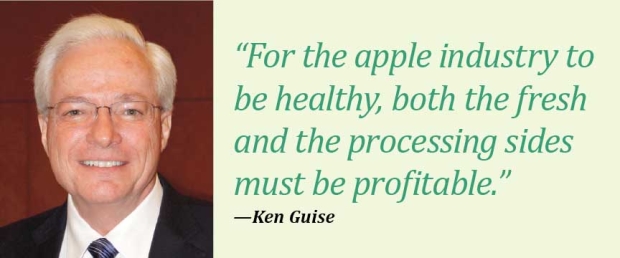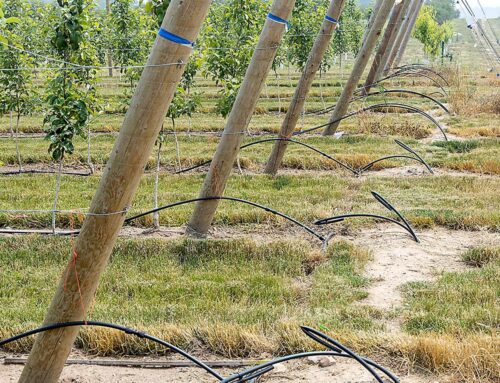With so much emphasis on exciting new fresh-market apple varieties, it is easy to forget that Americans consume more apple products processed than fresh. Even with the presence of Honeycrisp, Cosmic Crisp, and EverCrisp, apple crisp has not disappeared.
On the average, Americans consume about 25 pounds of applesauce, apple pie, and apple juice each year and less than 20 pounds of fresh apples.
While many of these processed products originate as sort-outs from fresh apple packing lines—especially in Western production areas—there are places in the country—like Pennsylvania—where orchardists grow apples especially for processing or take them directly to the processor with no attempt to sort out of fresh market apples.
Good Fruit Grower asked two important figures in the apple processing world: What does the future look like for processing apples?
One was Ken Guise, the president and chief executive officer of Knouse Foods, which operates six processing plants, one in Michigan and five in Pennsylvania, including the one at company headquarters in Peach Glen, where Guise is located.
The other was with Dawn Drake, manager of the Michigan Processing Apple Growers Association.
This organization, a subsidiary of Michigan Farm Bureau’s MACMA (Michigan Agricultural Commodity Marketing Association), has a special mandate under Michigan law to bargain with processors on behalf of its members for price and other terms of sale.
Guise and Drake represent two sides of the equation—one needing processing apples as the basis of their business, the other supplying those apples. They sit on opposite sides of the negotiating table. In another sense, however, they are on the same side, because both are cooperatives made up of growers of these apples.
Processor’s view
 Guise said 95 percent of his company’s apple receipts come directly from orchards and only about 5 percent from warehouse packouts.
Guise said 95 percent of his company’s apple receipts come directly from orchards and only about 5 percent from warehouse packouts.
With reports coming from Washington State about apples being dumped in fields to rot and prices for juice apples falling to $20 a ton—if they can be sold at all—it’s startling to hear an apple grower—and Guise himself grows apples—say he’s planting blocks of apples for processing.
In fact, he said, “I’m planting all processing varieties.”
Knouse Foods is the largest apple processor in the eastern United States, handling about 10 million bushels each year. Ninety-five percent of them are peelers that go for sauce and slices and about 5 percent go for juice, Guise said.
“For the apple industry to be healthy, both the fresh and the processing sides must be profitable,” he said. “It takes both sides to make a healthy industry, and one forces the other.”
Sometimes there are disruptions and imbalances. For several years, apple juice concentrate from China and other countries drove down the price of domestic juice apples.
“Foreign concentrate was—and is—a disruption,” Guise said.
But even there, change happens to establish a new balance. There is real growth in apple beer and in apple hard cider, both of which are strengthening the juice apple market, he said, and “squeezer packs” of applesauce in tubes are boosting the market for apple sauce, putting it into the convenience and snack food market.
Pennsylvania growers send a high percentage of their apples to processing—perhaps 70 percent. That’s higher than New York, which is about 60/40, or Michigan, which is about 50/50. Guise said in Pennsylvania, 65 to 70 percent of all the apples grown go to Knouse Foods.
On the average, all processing apples in Pennsylvania bring $200 a ton. In Michigan, processors pay more for peeler quality apples, about $250 a ton, but more Michigan apples go to juice at a lower price, he said.
What price?
Guise says that $200 a ton is sufficient to draw enough apples to the processing side.
The best varieties for processing are large apples, Guise said. So while Gala is a good apple for fresh market, the market for small Gala is weak.
“We want size,” Guise said. “With our automatic peelers doing 100 apples a minute, we would much rather be doing something besides Gala.” Small Galas move to the cheaper juice apple market.
Varieties that work well as peelers include Crispin (Mutsu), Jonagold, Granny Smith, Idared, York Imperial, and Rome.
Honeycrisp apples work because they are large—sometimes too large for fresh sale—and processors don’t worry about some of its cosmetic issues. Peeling takes care of surface blemishes like bitter pit and superficial scab.
The best varieties for processing are large and bear annually, Guise said. Honeycrisp sometimes doesn’t color well—but that’s not a problem for processors.
Processing often saves blocks of apples that are in trouble for failing to color properly or have issues like apple scab, bitter pit, sunburn, or hail damage.
“The cost of growing apples for processing is significantly less,” Guise said. Since color is not an issue, trees need not be pruned as precisely. While they may need to be chemically thinned to achieve size, they probably won’t need to be hand thinned.
“We can tolerate some bruising, especially fresh bruising,” Guise said.
So picking can proceed faster and with less delicacy—and certainly without expensive work like stem clipping.
Trees cost less, he added. Growers of processing blocks typically have non-patented, non-managed varieties, but new plantings are at the same high densities as fresh varieties.
Maintenance costs are less.
“Processing growers use fewer sprays and somewhat cheaper materials,” Guise said.
Back in the days before controlled atmosphere storage, apples that matured late and stored well were highly valued, not only for fresh market but for processing.
“That’s less of an issue now that we can keep most any apple for a year,” he said.
Processing apples a byproduct
 Drake said very few Michigan apple growers think of themselves as growers of processing apples.
Drake said very few Michigan apple growers think of themselves as growers of processing apples.
“They all consider themselves to be fresh market growers because that is where the higher returns come from.”
Michigan is said to be the hardest place to grow apples because of the climate and the insect and disease pressures, she said. As a consequence—whether growers like it or not—65 to 70 percent of Michigan’s apple crop winds up in the processing market, either going directly to the processor or through fresh packers.
Processors generally have a goal of how many apples they want to buy and what products they want to make—and sometimes they have special needs for certain varieties. While companies would rather buy on the spot market, they may face the need to contract with growers.
That happens with Northern Spy growers in Nova Scotia, who grow the variety specifically for two pie companies.
While some varieties are considered superior for processing, because of size or some other feature, growers in Michigan have been taking out Idareds, Romes, Winesaps, and Empires as they aspire to more profitable fresh market varieties.
In her job as negotiator on behalf of growers, Drake wants to find a home for their processing-quality apples, but supply and demand is not easy to even out.
From the growers’ point of view, they want as many apples in fresh pack as possible.
In years of short apple supply, packers will put a higher proportion into fresh pack, even if they need to be less choosy about what they pack. In years of large supply, the pressure mounts on processors to take more apples.
Sometimes growers have to take the bitter with the sweet.
“Everybody loves Honeycrisp, but processors find it hard to use the table sorts,” Drake said. “They tend to make runny applesauce, and there are more patulin issues with the juice.”
Phil Pitts, who runs the sales desk at MACMA, has found a small market with companies selling Honeycrisp juice. But, in the future, as Honeycrisp supplies mount, what happens to Honeycrisp sort-outs will be a growing issue.
Ideally, Drake agrees, a good dual-purpose apple would be wonderful.
In Michigan, which in some years has faced issues of poor color, apple scab, and poor size, growers like to make the decision at harvest whether to sell a whole block of apples directly to a processor and not incur packing charges if there are quality issues, Drake said. Varieties that have worked best in recent years are Idared, Rome, and Golden Delicious.
Drake does not think that current prices for processing apples are attractive enough to entice growers to plant blocks specifically for processing. “$200 a ton is not a good price,” she said.
In recent years, the association has been able to achieve prices of about $240 a ton for hard varieties and $200 a ton for soft varieties, for the larger fruit for peeling.
When conditions are like they were with last fall’s crop, Eastern growers are happy that the West is a long way away. Processors in the East are still willing to pay for processing apples, while processors in the West are turning apples away and growers are dumping them.
Eastern prices for processing apples are generally not strong enough to entice Western growers to incur the transportation charges to bring apples East, but in 2012 that happened when freezes decimated the Eastern crop. That year, Washington growers fared well in both fresh and processing markets.
But the Eastern growers’ goal is to put more apples into fresh market, where they compete head on with Western apples. •






Leave A Comment